NVIDIA GeForce GTX 670 Review Feat. EVGA: Bringing GK104 Down To $400
by Ryan Smith on May 10, 2012 9:00 AM ESTOC: Power, Temperature, & Noise
Our final task is our look at GTX 670’s overclocking capabilities. Based on what we’ve seen thus far with GTX 670, it looks like NVIDIA is binning chips based on functional units rather than clockspeeds. As a result GTX 670 could have quite a bit of overclocking potential, albeit one still limited by the lack of voltage control.
| GeForce 600 Series Overclocking | |||||
| GTX 670 | EVGA GTX 670SC | GTX 680 | |||
| Shipping Core Clock | 915MHz | 967MHz | 1006MHz | ||
| Shipping Max Boost Clock | 1084MHz | 1188MHz | 1110MHz | ||
| Shipping Memory Clock | 6GHz | 6GHz | 6GHz | ||
| Shipping Max Boost Voltage | 1.175v | 1.162v | 1.175v | ||
| Overclock Core Clock | 1065MHz | 1042MHz | 1106MHz | ||
| Overclock Max Boost Clock | 1234MHz | 1263MHz | 1210MHz | ||
| Overclock Memory Clock | 6.9GHz | 6.6GHz | 6.5GHz | ||
| Overclock Max Boost Voltage | 1.175v | 1.162v | 1.175v | ||
Because of the wider gap between base clock and boost clock on the GTX 670 we see that it doesn’t overclock quite as far as GTX 680 from a base clock perspective, but from the perspective of the maximum boost clock we’ve slightly exceeded the GTX 680. Depending on where a game lands against NVIDIA’s power targets this can either mean that an overclocked GTX 670 is faster or slower than an overclocked GTX 680, but at the same time it means that overclocking potential is clearly there.
We’re also seeing another strong memory overclock out of a GK104 card here. GTX 680 only hit 6.5GHz while GTX 690 could hit 7GHz. GTX 670 is only a bit weaker at 6.9GHz, indicating that even with the relatively small PCB that NVIDIA can still exceed the high memory clocks they were shooting for. At the same time however this is a luck of the draw matter.
The EVGA card meanwhile fares both worse and better. Its gap between the base clock and and maximum boost clock is even larger than the reference GTX 670, leading to it having an even lower overclocked base clock but a higher overclocked maximum boost clock. The real limiting factor however is that it couldn’t reach a memory overclock quite as high as the reference GTX 670 – again, luck of the draw – which means it can’t match the overclocked reference GTX 670 as it’s going to be more memory bandwidth starved more often.
Moving on to our performance charts, we’re going to once again start with power, temperature, and noise, before moving on to gaming performance. We’ll be testing our GTX 670 cards at both stock clocks with the maximum power target of 122% (170W) to showcase what is possible at validated clockspeeds with a higher power cap, and a true overclock with a maximum power target along with the largest clock offsets we can achieve.
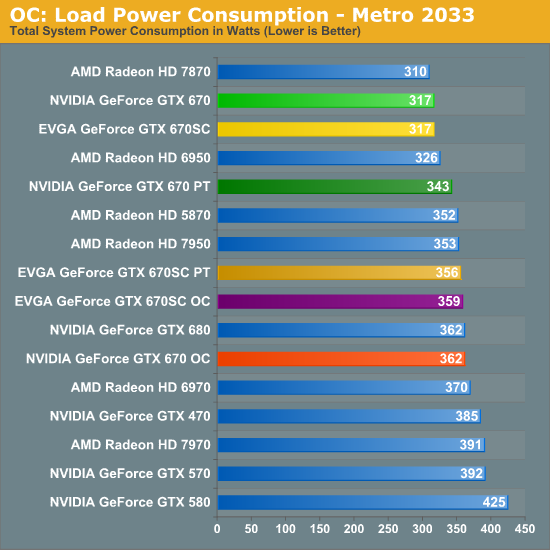
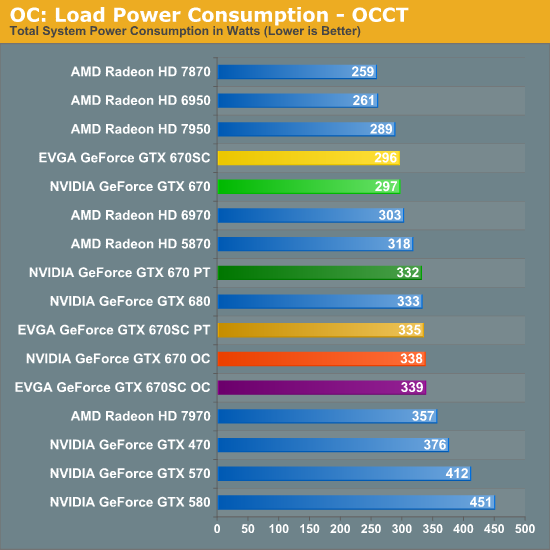
Not surprisingly, since we’re almost always operating within the realm of the power target as opposed to the TDP on the GTX 600 series, our power consumption closely follows our chosen power target. Cranking up the power target on the GTX 670 for example to 170W puts us within 6W of the GTX 680, which itself had a 170W power target in the first place. This is true for both Metro and OCCT, which means power consumption is very predictable when doing any kind of overclocking.
This also means that power consumption is still 18W-30W below the 7970, which in turn means that if these overclocks can close the performance gap, then the GTX 670 still has a power consumption advantage.
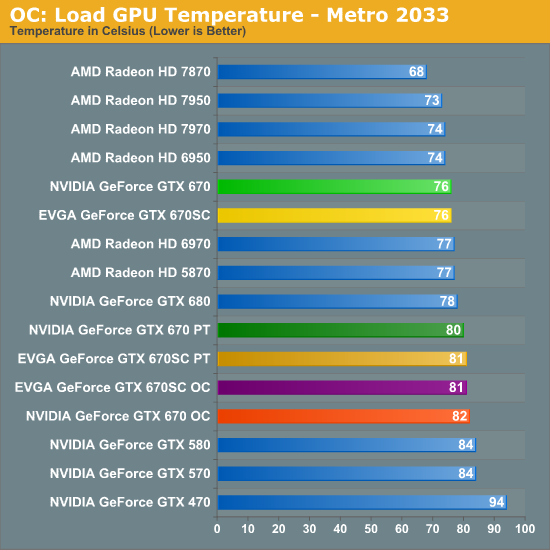
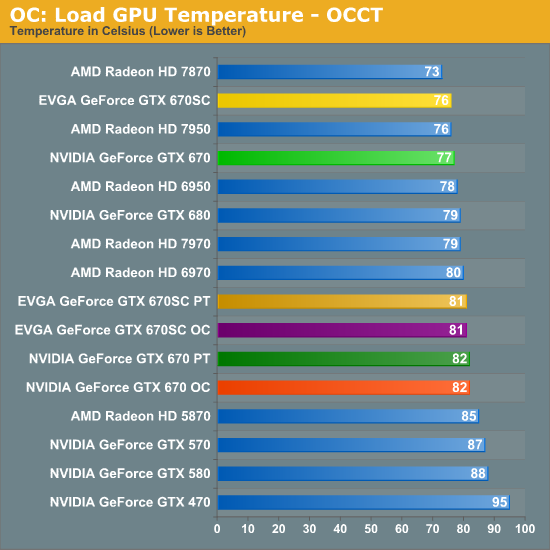
As to be expected, with an increase in power consumption comes an increase in load temperatures. However the fact that we’re only able to increase power consumption by about 30W means the temperature rise is limited to 4-5C, pushing temperatures into the low 80s. This does end up being warmer than the equivalent GTX 680 however due to the 680’s superior heatsink.
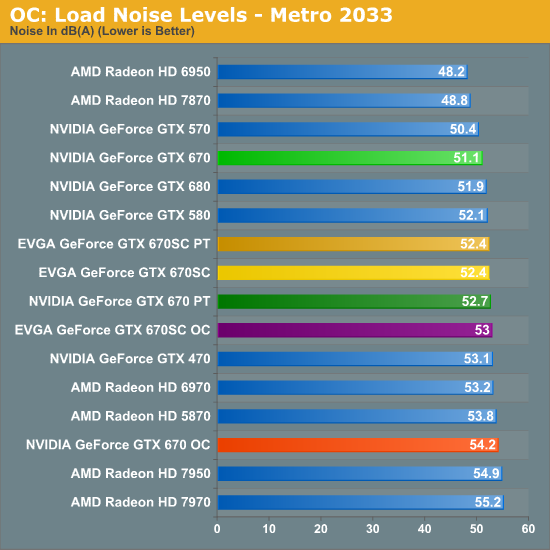

Finally, when it comes to noise we’re also seeing the expected increase, but again it’s rather small. Under Metro the amount of noise from the reference GTX 670 rises by under 3dB when pushing the power target higher on its own, while it rises 3dB when adding in our full overclock. Again the smaller cooler means that the GTX 670’s fan has to work harder here, which means our gaming performance may be able to reach the GTX 680, but our noise is going to slightly exceed it. As a point of reference, in the process we’ll also exceed the GTX 580’s noise levels under Metro. Still, in both OCCT and Metro none of our GTX 670 cards exceed the Radeon HD 7900 series, which means we've managed to increase our performance relative to those cards without breaching the level of noise they generate in the first place.










414 Comments
View All Comments
CeriseCogburn - Sunday, May 13, 2012 - link
Glad you claim to, the last 4 flagships historical pricing was $499. Time to face the facts you've been avoiding chizow, in order to bolster your conspiracy theory.mevans336 - Thursday, May 10, 2012 - link
If AMD responds with another 7970 like price-drop on the 7950 and can get it down to the low $300 range, I may wind up owning my first AMD card ever. Although, I'm not holding my breath for such a dramatic decrease.Jraptor59 - Thursday, May 10, 2012 - link
I have twice in my life, so far, gotten a AMD card over a Nvidia and regretted it so much I only buy Nvidia now.JlHADJOE - Thursday, May 10, 2012 - link
I've bought AMD once, but was very happy with it.Specifically, a 9500 256bit that unlocked into a 9700.
Kept it for quite a while, skipping Geforce 6 and 7 series, as well has ATI X1 and X2 series. I was very glad I did so, because my next upgrade was the 8800GT which was IMO the best bang-for-the-buck GPU ever made.
just4U - Thursday, May 10, 2012 - link
I buy alot of video cards.. not only for systems I build for others but also for myself.. and on average since the Radeon 8500 I see no reason not to buy from either company.Spunjji - Thursday, May 10, 2012 - link
Agreed; 8500 was a bitch.Spunjji - Thursday, May 10, 2012 - link
Classic! That little 9500 Pro was a beast. Looks like you hit the perfect generation tipping points too, as the 8800GT was a hell of a card.SlyNine - Thursday, May 10, 2012 - link
Than they released the 9600pro, I hated that card to no end (even tho I never bought one).But when I went to build other people computers, and couldn't choose the 9500. It made me sad.
anubis44 - Saturday, May 12, 2012 - link
The 8800GT was a great card, but the 4850 was the best bang for buck card I've seen so far.Spunjji - Thursday, May 10, 2012 - link
What on Earth did you buy that sucked so hard? I'm genuinely interested - I've been buying cards from both sides since the GeForce DDR and the only bad product I ever got was a failtastic G86-based mobile part. That black mark aside both vendors have served me well.